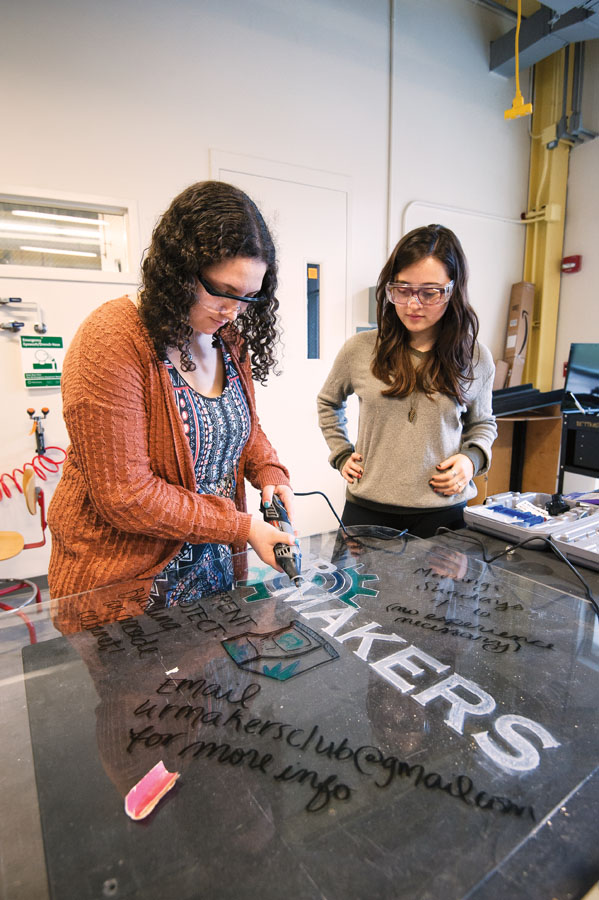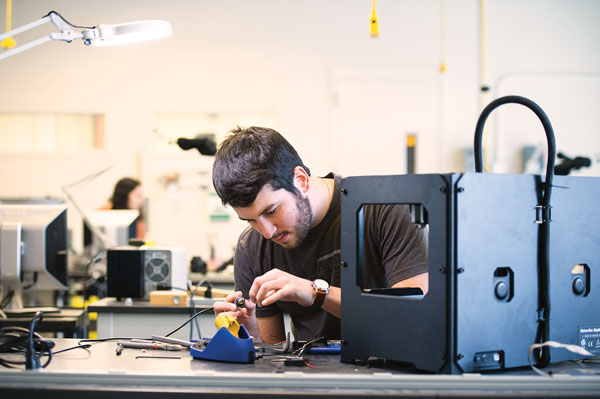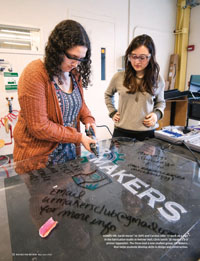 HANDS-ON: Sarah Harari ’16 (above) and Carolyn John ’17 work on a sign in the fabrication studio in Rettner Hall; Chris Smith ’18 repairs a 3-D printer (below). The three lead a new student group, UR Makers, that helps students develop skills in design and construction. (Photos: Adam Fenster)
HANDS-ON: Sarah Harari ’16 (above) and Carolyn John ’17 work on a sign in the fabrication studio in Rettner Hall; Chris Smith ’18 repairs a 3-D printer (below). The three lead a new student group, UR Makers, that helps students develop skills in design and construction. (Photos: Adam Fenster)A new group—UR Makers—is taking advantage of the resources of the fabrication studio in the Ronald Rettner Hall for Media Arts and Innovation, where high-tech 3-D printers are available alongside an array of old-school machinery, such as drills and lathes. The group’s leaders—Sarah Harari ’16, a computer science and digital media studies major from Potomac, Maryland; Carolyn John ’17, a mechanical engineering major from Maplewood, New Jersey; and Christopher Smith ’18, a Scituate, Massachusetts, resident who hasn’t yet chosen a major—aim to draw students from all areas of interest to learn about fabrication and design through hands-on practice.
What is UR Makers?
Sarah: It’s a collaborative and interdisciplinary group that brings together engineering and the arts. We design, budget, and carry out student-run projects from start to finish in the fabrication studio of Rettner Hall, home to our “makerspace.” We assist with educating our peers about the proper use of the 3-D printers and other technical equipment. We’ve also carried out events and brought in faculty who support our vision for interdisciplinary work in an extracurricular setting.
 (Photo: Adam Fenster)
(Photo: Adam Fenster)When did you establish the group?
Sarah: The idea for UR Makers evolved throughout this school year. We had a revolving door of ideas and leadership, but one common goal: to facilitate a space where students of different disciplines can work together on projects of varying magnitude.
Who’s involved?
Sarah: We welcome students from all majors. Bringing together a group of students with diverse skill sets helps us to learn from each other and to improve our understanding of the intricacies of the tasks we take on.
What are some projects the group has done to date?
Carolyn: We finished building an LED cabinet this spring. The top half is a Plexiglas LED sign with our logo etched into it, and the bottom half has cabinet space for storage. We designed it ourselves, and during our weekly meetings we divided the work that had to be done between the people who showed up. No experience was required, so our members learned how to use a variety of tools such as jigsaws and Dremels. Currently we are sketching plans and writing a proposal for an old-fashioned arcade cabinet.
What do you gain from hands-on experience?
Sarah: It complements our academic experiences. Working with our peers who are pursuing different degrees and sharing ideas gives us the opportunity to gain a new perspective on project-based work and to broaden our horizons outside of the curriculum.
Chris: We’re promoting an environment where you don’t have to be an engineer to build something, a programmer to code, or an artist to design. It’s an environment where we hope that students can broaden their skills, make friends, learn to look at problems and projects from different angles, and ultimately create something that they are proud of.
Are members working on individual projects or do you all work as a group?
Sarah: Our meetings and projects are collaborative and group-oriented from start to finish. The collaborative nature of the group is representative of real-world experiences that many of us will meet in our coursework and future careers.
Can you describe the fab studio? What do you like best about it?
Chris: The fab studio is a great place simply because it is so multi-purpose. You can 3-D print something, solder, code, 3-D model, design, or work on a project with friends. It’s also a great place for the community. It’s not dominated by one group: you’ll see computer science majors and mechanical engineering majors working on class projects, Baja members painting this year’s newest buggie, librarians making portable 3-D scanners—the list goes on and on. The best part of this community that we have congregating in the room is their help. Even if you’re working alone there is usually someone around who is willing to help or teach you how to complete the project you’re working on. Another great resource in the room is Jim Alkins, who runs the fabrication shop attached to the studio. He’s there during the week and is a great resource to learn about the tools in the shop and machining parts.
How do you hope to see the group evolve after its first year?
Carolyn: Currently, the bulk of our members are from engineering or natural science backgrounds. As the club expands, we hope to include students from all majors so that we can get different perspectives on projects.

